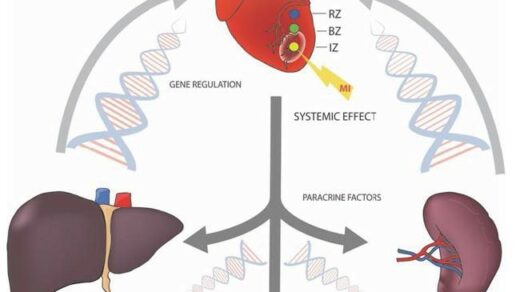“[…] studies that employ TP53-wild type cancer cells and their isogenic derivatives may systematically fail to appreciate the full scope of p53 functionality.”
A new study from the Sidney Kimmel Comprehensive Cancer Center and Johns Hopkins University School of Medicine, published in Oncotarget, reveals that the gene p53, long known as the “guardian of the genome,” may be even more powerful than previously thought. By studying it in non-cancerous human cells, researchers discovered how p53 stops risky cell growth and uncovered two new potential targets for cancer therapy.
Understanding p53: The Genome’s Guardian Against Cancer
The p53 gene is one of the most important natural defenses our body has against cancer. When functioning properly, p53 detects damage in a cell’s DNA and either stops the cell from dividing or pushes it to self-destruct. This process helps prevent potentially dangerous mutations from spreading. However, many cancers find ways to silence or mutate p53, allowing uncontrolled growth and resistance to treatments.
Studying p53 in a clear and accurate way has long been a challenge. Most cancer cell models used in research already carry numerous genetic mutations, which can mask or alter how p53 truly functions. To fully understand this vital tumor-suppressing gene, scientists needed a model that closely resembled healthy, genetically stable human cells—yet could still be maintained and studied over time in the laboratory.
The Study: Exploring p53 in Normal and Cancer Cell Models
Researchers Jessica J. Miciak, Lucy Petrova, Rhythm Sajwan, Aditya Pandya, Mikayla Deckard, Andrew J. Munoz, and Fred Bunz explored p53 activity using a uniquely suitable cell line: hTERT-RPE1. These non-cancerous human cells are immortalized using telomerase, meaning they continue dividing like cancer cells, but without the chaotic mutations seen in tumors. This makes them an excellent model for studying how p53 operates in near-normal conditions.
To understand how p53 influences cancer, the team also worked with DLD-1, a colorectal cancer cell line that carries a defective version of the p53 gene. By restoring wild-type (normal) p53 in DLD-1, the researchers could observe how p53 reactivation impacts tumor-like behavior.
To strengthen their findings, the study also included three more colorectal cancer cell lines: HCT116, RKO, and SW48. These lines originally contained wild-type p53, and researchers created p53-deficient versions of each to compare how gene expression changes depending on p53 status. This combination of models—normal and cancerous, mutated and corrected—allowed a comprehensive, side-by-side comparison of p53’s behavior when functional versus when it is absent.
This study, titled “Robust p53 phenotypes and prospective downstream targets in telomerase-immortalized human cells, was recently published in Oncotarget, Volume 16.
Results: p53 Restoration Slows Cancer Growth and Boosts Radiation Sensitivity
In DLD-1 cancer cells, restoring p53 slowed cell growth, triggered signs of aging (senescence), and made cells more vulnerable to radiation. In contrast, deleting p53 in hTERT-RPE1 cells had the opposite effect: it made them grow faster and resist radiation, clear signs that p53 was keeping them in check.
Interestingly, one of the hTERT-RPE1 cells developed a rare cancer-associated mutation (A276P) in p53, previously observed in breast and ovarian cancers. This mutated version not only failed to protect the cells, but it also blocked the remaining healthy p53 from working, a phenomenon known as a dominant-negative effect, common in aggressive cancers.
The study also identified two new genes—ALDH3A1 and NECTIN4—as being directly regulated by p53. ALDH3A1 helps neutralize harmful chemicals and oxidative stress. NECTIN4 is a cell-surface protein present in many cancers, like bladder and breast cancer, and it is already the target of an FDA-approved drug, enfortumab vedotin.
Breakthrough: Rare p53 Mutation and Two New Drug Targets
The use of a “clean” cell system to observe p53 in action was novel, since most cancer models hide its full abilities, but in hTERT-RPE1, p53 was able to control cell growth, cause the cell cycle to arrest, and regulate key genes—just as it would in the body. The discovery of a real-life p53 mutation (A276P) further proves that this system can mimic the pressures cells face during early cancer development.
The identification of ALDH3A1 and NECTIN4 as p53 direct targets adds even more value. NECTIN4 is especially exciting because it is already drug-targetable, meaning this new insight could lead to better use of existing therapies or even new ones.
Impact: New Paths for Cancer Therapy Using p53
This research highlights the value of hTERT-RPE1 as a reliable model for understanding cancer biology and p53’s role in it. By using genetically stable cells, scientists were able to uncover both expected and entirely new behaviors of p53 that are hidden in traditional cancer models.
Furthermore, pinpointing ALDH3A1 and NECTIN4 as direct targets leads the way for new treatments and elucidates the aggressiveness in some cancers with intact p53. Therapies that enhance p53 function or block harmful p53 mutations could make traditional treatments like radiation and chemotherapy more effective and less toxic.
Future Perspectives and Conclusion
Although this study was performed using laboratory cell models, its findings have the potential to influence cancer research and treatment far beyond the lab bench. The next step will involve testing these discoveries in animal models and eventually in clinical settings to determine the most effective ways to take advantage of these newly uncovered p53 pathways.
In particular, the identification of ALDH3A1 and NECTIN4 as p53-regulated genes presents exciting opportunities. These genes could serve as biomarkers to guide treatment decisions or as targets for new drugs, especially in cancers where p53 is still functional. Exploring these possibilities could help refine precision medicine strategies and lead to more personalized, effective therapies for patients.
Click here to read the full research paper in Oncotarget.
_______
Oncotarget is an open-access, peer-reviewed journal that has published primarily oncology-focused research papers since 2010. These papers are available to readers (at no cost and free of subscription barriers) in a continuous publishing format at Oncotarget.com.
Oncotarget is indexed and archived by PubMed/Medline, PubMed Central, Scopus, EMBASE, META (Chan Zuckerberg Initiative) (2018-2022), and Dimensions (Digital Science).
Click here to subscribe to Oncotarget publication updates.
For media inquiries, please contact media@impactjournals.com.



